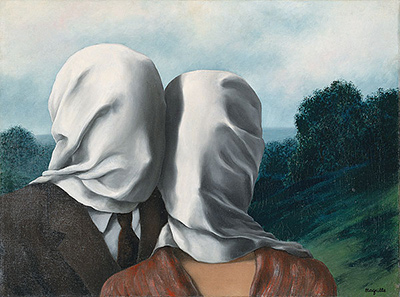Rene Magritte was an influential surrealist painter born in Belgium 21 November 1898. His paintings are known for their thought-provoking nature, achieved by the clever use of normal objects in strange surroundings and dimensions. He hoped to challenge the observer’s preconditioned view of the reality they know through his witty images.
The many works of art he created inspired many artists in the pop, conceptual and minimalist art scenes. He passed away on 15 August 1967 (aged 68). Unlike the other artists in the surrealist movement such as Max Ernst and Salvador Dali who pained images that were more dream-like than realistic to achieve surrealism, Magritte used realistic depictions to achieve his goal. He was a leading member of the surrealist movement in in 1927 after deciding to move to Paris and becoming friends with Andre Breton, a member of the movement. He made the move to Paris after his first art exhibition in Brussels received negative feedback, putting him in a depressed state. Magritte and Dali were the most influential surrealist artists on the 20th century. Magritte’s earlier paintings were influenced by the futurism, cubism and impressionism movements. He took a new direction with his work in 1924. His first surrealist piece was The Lost Jockey that was finished in 1926. Some of the other paintings he is well known for include The Treachery of Images, The Son of Man, The Portrait, On the Threshold of Liberty and Elective Affinities.
Les Amants I, also known as The Lovers, is a painting by the artist Rene Magritte. It was one of the set of paintings created by Magritte in 1927-28. It was believed to be finished in 1928 but it was not dated. It depicts two figures that have their faces shrouded by white cloth. The other paintings in the set include The Central Story, The Invention of Life and The Lovers II. It is currently held in the Australian National Gallery with the very similar The Lovers II held in a private collection belonging to Richard S. Zeisler in New York. Unlike The Lovers I, the second painting depicting the two shrouded figures is attempting to kiss.
Initially, it was believed that the set of paintings was inspired by a traumatic event experienced by Magritte in his youth. His mother committed suicide by drowning herself in a river and was found with her dress shrouding her face. It was believed that Magritte was present when the body was recovered from the river Sambre. However, it was later discovered that this was a story created by one of their servants at the time. As such, the inspiration of the painting is attributed to Magritte’s imagination. Furthermore, Magritte had a fascination with the shadowy hero in a novel from 1913 known as Fantomas, later adapted into a film. The character’s identity was always concealed by a cloth or stocking that was placed over his head.
Magritte never revealed his true inspiration for the art piece as he believed that explanations took away from the observer’s personal experience of his work. His style deliberately broke the assumption that his paintings were just an expression of his own neurosis or personal fantasy. Each of his works of art was calculated in order to unlock a dark side in the mind of the observer. In The Lovers, the man and women are seen in a fond gesture, seemingly having their picture taken. The background lets the viewer think that the couple are at a holiday destination with what appears to be the Normandy coast at their back. The image of a normal couple having their photograph taken while on holiday is broken completely by the white cloth over each of their heads. It changes the image into one of suffocation, alienation and even death. Viewed from the mind’s eye, the painting becomes chillingly real.




